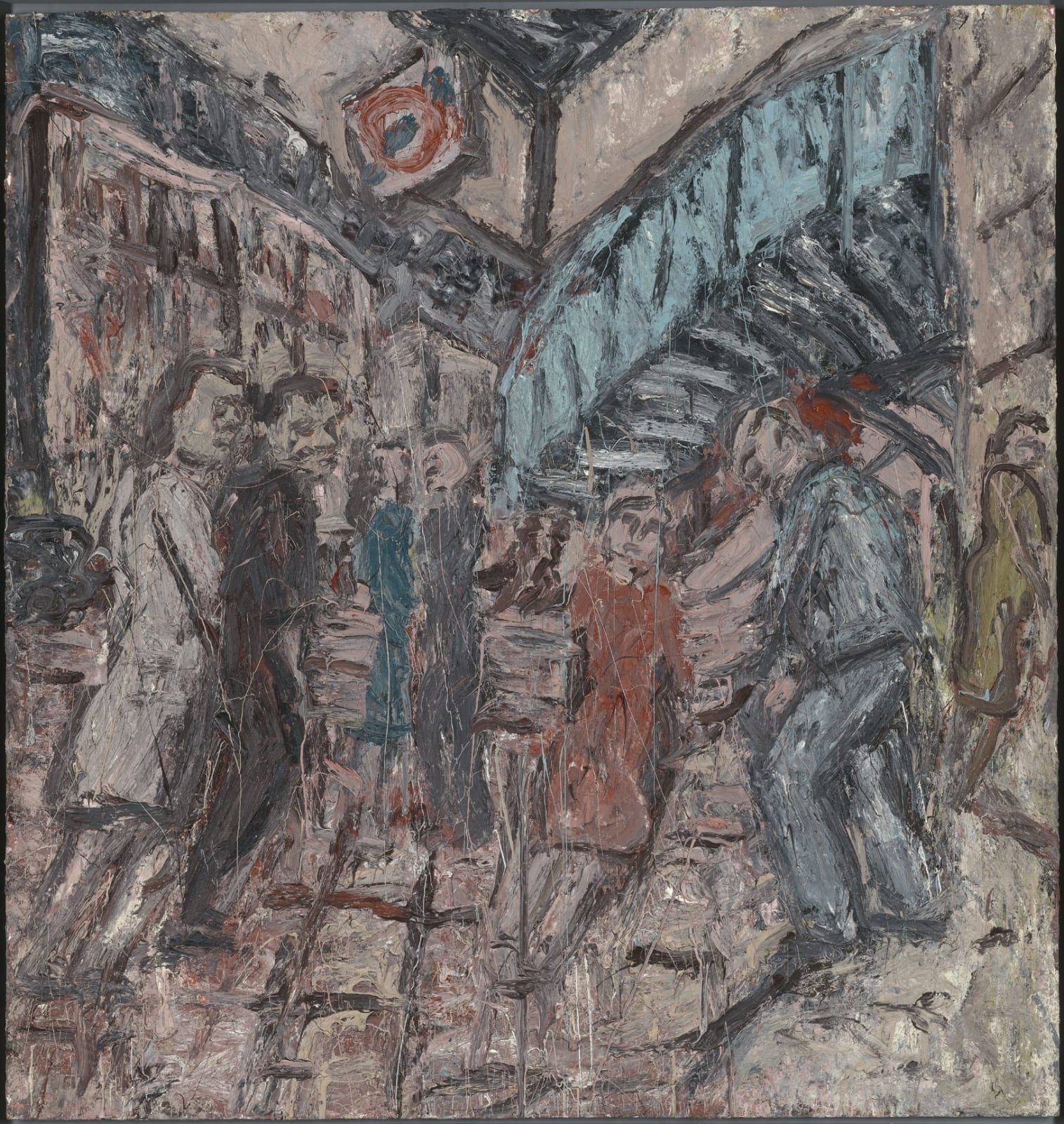Leon Kossoff 1926-2019
198.2 x 188 cm
Further images
Leon Kossoff was born in Islington and, apart from evacuation during the war and four years’ military service in Europe, he has only ever lived and worked in the city. He has painted some areas (Shoreditch, Hackney, Kilburn) over and over again, focusing on places of intense human activity, such as the underground, train stations, parks and swimming pools. Kossoff’s art is founded on a continuous process of drawing directly from life, working in situ at different times of the day and in all weathers. Once he has ‘found’ the final drawing, the one which captures the essence and experience of the landscape before him, he works from this sketch, transferring his marks onto board in oil paint.
As the artist has explained, ‘Every painting that has emerged has been preceded by months, sometimes, years, of drawing. The final painting, the one you see, is made from a drawing made on that day and is about an entirely new experience of the subject. The painting is scraped down before it is worked upon. The same approach is used when painting friends in the studio.’ 2
As the artist describes here, paintings are often scraped back, to be re-painted again and again, (or abandoned), and invariably the final image is the result of a single sitting which lasts for several hours.
Kossoff combines his dedication to creating images from life with the meticulous study of paintings by the Old and Modern Masters before him. The study of art history is fundamental to Kossoff’s artistic rhetoric and places such as the National Gallery and the Royal Academy are a great inspiration. Kossoff’s first visited the National Gallery when he was just ten years old and it was around this time that he first encountered Rembrandt’s A Woman Bathing in a Stream, a moment he has described as a life-changing experience. During the 1950s he started to make drawing trips to the Gallery and this was to be the beginning of a life-long practice. Kossoff would draw endlessly from the works housed here and in the Royal Academy, creating a multitude of drawings directly from paintings by Rembrandt, Poussin, Goya and Velasquez, amongst others. He has also made several paintings which borrow directly from past masterpieces such as From Rembrandt: Ecce Homo, 1999 and From Velazquez: Don Sebastian de Morra, c.1985. The intense study of these masterpieces has had a vital impact on Kossoff’s paintings, portraits and landscapes alike, and while his subjects are overwhelmingly contemporary, his paintings share a monumental and timeless quality with the Old Masters.
In his painting Kossoff succeeds in presenting scenes of modern, everyday life and transforming them into lasting images of the transitory nature of human life. Outside Kilburn Underground, March,1985, like the Tate Gallery’s Booking Hall, Kilburn Underground, (Fig 1.) painted two years later, has the same energy, dynamism and grandeur that one finds in those great masterpieces studied by the artist. Kossoff approaches the scene as if from slightly below and as a result, the station and figures loom up ahead of us with majestic force. The people are pictured in constant flux, carrying movement across the picture plane and drawing the spectator’s eye into the recesses of the canvas. They are at once, part of the mass of human activity and at the same time, completely alone. There is a deep sense of emotion present in these images, whether it be sadness, loneliness or just a recognition of the singular nature of human life in a large city. As with his later series of Kings Cross St Pancras, two figures cross the canvas in one direction and two in the other. Kossoff uses the colour of the figures’ clothes to add rhythm to his composition and here, as with a Lowry painting, there is one figure dressed in red and one in blue.
The sense of depth created by the figures in the painting is further enhanced by Kossoff’s working process, which results in thickly worked layers of paint and drips that fall down the picture’s surface. Kossoff makes no attempt to remove these marks, instead he allows the paint to run freely down the canvas, embracing the unexpected outcomes of this process. The painting is sensuous and tactile and our experience of the work is not only intellectual but also deeply physical. The artist’s own words in describing his process reveal this physicality,
‘…moved by unpremeditated visual excitement, the painting, like a flame, flares up in spite of oneself, and, when the sparks begin to fly, you let it be.'3
1 Anders Kold, In the Thick of the Moment’ Leon Kossoff, Selected Paintings and Drawings, 1956- 2000, Louisiana Museum of Art exhibition catalogue. 2004, p12
2 Ibid, p.12
3 Simon Wilson, Tate Gallery: An Illustrated Companion, Tate Gallery, London, revised edition 1991, p.251
Provenance
Anthony D'Offay, London
Private Collection, UK, 1992
Exhibitions
Jerusalem, The Israel Museum, British Figurative Painting of the 20th Century, The British Council, November 1992- February 1993, illus colour, p.77
Literature
Andrea Rose, Leon Kossoff, Catalogue Raisonné of the Oil Paintings, Modern Art Press, London, 2021, cat no.307, pp 378-379 and the cover image





